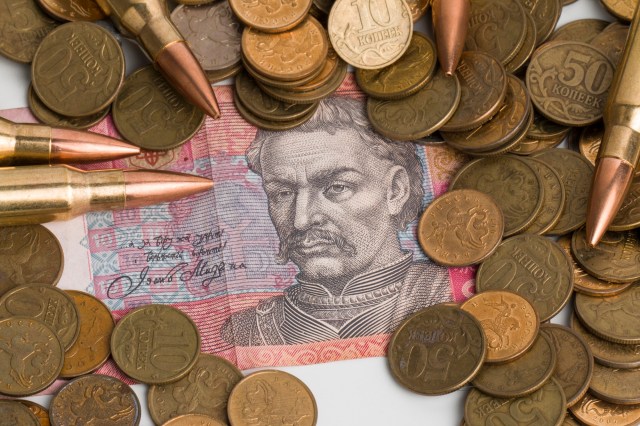Russian and Ukrainian paper money and coins. Getty.

No one can doubt that Vladimir Putin has extended Russia’s influence. It can be felt in a very direct way by some of his immediate neighbours – Ukraine, Georgia and Moldova. Further afield, there’s Russia’s pivotal intervention in the Syrian conflict – and the various rumours and allegations of interference in the democratic politics of several countries, including the United States. All in all, Putin appears to be running rings around an increasingly paranoid West.
As Michael Dempsey writes in a piece for Bloomberg, the Russian President is garnering plaudits at home and grudging respect elsewhere:
“Many Western analysts and policy makers believe that Putin has played a weak hand skillfully, evolved from a tactician into a first-rate strategist, and won a series of major victories for Russian diplomacy…
“This attitude is deeply held inside Russia as well, where recent polling shows that nearly 90 percent of the public has confidence in Putin’s handling of world affairs.”
But, Dempsey argues, this narrative is misleading:
“In my opinion, it pays too little attention to the long-term costs of Putin’s foreign engagements…”
These engagements have embroiled Russia in ongoing sets of commitments – many of them military and most of them financial. Consider Syria:
“…while Assad currently enjoys the upper hand on the battlefield, there are still tens of thousands of embittered and heavily armed opposition fighters who will never accept his leadership. There are also thousands of Islamic State and al Qaeda-affiliated extremists who, despite battlefield setbacks, are likely to continue operating in Syria, meaning that Russian forces will have to remain engaged in combat there for the foreseeable future – at considerable cost and with more casualties…
“…as long as Assad remains in power, the international community is unlikely to provide significant reconstruction assistance to Syria, guaranteeing that Russia will be forced to foot at least part of the reconstruction cost…”
As for the Russian near abroad (i.e. the ex-Soviet bloc), Putin’s support for breakaway statelets like Transnistria and South Ossetia – largely unrecognised by the rest of the world – isn’t cost-free. Putin’s intervention in Ukraine was intended to shift the whole country back into the Russian sphere of influence, but has instead created two additional financially-dependent client states in Crimea and eastern Ukraine (with an on-off military conflict in the latter).
There are other costs:
“Putin has turned a generation of Ukrainians against Russia – recent polling shows that while nearly 95 percent of Ukrainians viewed Russia positively as recently as 2010, that number now hovers in the low 40s, and is undoubtedly much lower than that in western Ukraine. Russia’s intervention in Ukraine also triggered a series of punishing economic sanctions from the U.S. and Europe…”
Note that these sanctions persist, despite Russia’s supposedly growing influence over Western politics. It is true that Putin has some fans in Europe and America, especially on the populist right. But on the other hand he has alienated liberal opinion – which used to be the biggest brake on the hawkish tendencies of the conventional right.
The irony is that in pushing back against the West, Putin has repeated many of the same mistakes made by America and her allies during the Bush-Blair era of ‘liberal interventionism’. Imposing oneself where one isn’t universally welcome is a high-risk strategy. Quick interventions become permanent commitments paid for in blood, treasure and international goodwill.
There are other, more effective ways of spreading one’s influence. For instance, by offering help, but waiting for an invitation before actually giving it. That way there is no diplomatic backlash, nor any long-term military or financial obligation.
In this respect the country with the smartest strategy is neither Russia nor America, but the People’s Republic of China.










Join the discussion
Join like minded readers that support our journalism by becoming a paid subscriber
To join the discussion in the comments, become a paid subscriber.
Join like minded readers that support our journalism, read unlimited articles and enjoy other subscriber-only benefits.
Subscribe